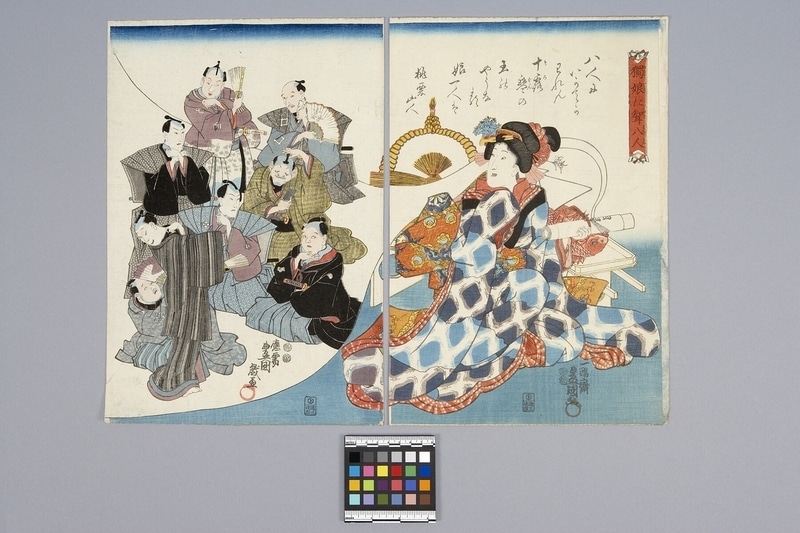Hitori musume ni muko hachinin Item Number: N2.1163 a-b from the MOA: University of British Columbia

Description
Two piece woodblock print showing eight male figures (part a) and one female figure (part b). The female on the right is resting on the ground leaning against a table, looking toward the men. She is holding a scroll and is wearing clothing that has a light and dark blue diamond pattern on a white background, covered with a red and yellow pattern. The men are on the left, in various positions, wearing clothing that has striped, dotted, checkered, and floral patterns in light blue, grey, yellow, purple, and black. Four men are holding fans, two men have a hand under their chins; one man has both hands crossed under his chin, and one man is admiring himself in a rectangular mirror. The ground is green, the background is white, and the top is blue. Above the female, there are black characters. In each lower right corner, there is a vertically rectangular black seal of the publisher (版元, hanmoto), a pair of circular black censor seals known as nanushi-in (名主印), one type of censor seal, and black writing in 'kanji'. The print is made of two vertically rectangular pieces, creating a horizontally rectangular image overall.
History Of Use
Date made refers to the date the design of this print was originally created. This print is likely an early impression/edition, as indicated by a pair of nanushi censor seals (名主印) Nanushi were individuals who added their censor marks to prints. This particular type of censor seal was used on woodblock prints issued during the period 1842-1852. The print was published by Enshūya Hikobē (遠州屋 彦兵衛).
Specific Techniques
Nishiki-e (錦絵, “brocade picture”), a type of multi-coloured woodblock printing, used in the ukiyo-e (浮世絵, “pictures of ‘floating world’”) genre of Japanese art.
Narrative
The various inscriptions on the print are as follows: on the right sheet, inside the red column: the title, 独娘に婿八人 (Hitori musume ni muko hachinin, Eight Bridegrooms for One Daughter); on the top: a poem by Momokuri Sanjin (桃栗山人), one of the pseudonyms of the comic author Utei Enba (烏亭焉馬, 1743–1822). Signed: Ichiyōsai Toyokuni ga (one of Kunisada’s signatures). Censor seal (circle, top): 衣笠, refers to Kinugasa Fusajirō (衣笠房次郎). Censor seal (circle, bottom): 吉村, refers to Yosimura Gentarō (吉村源太郎). Publisher’s seal (rectangular): ト、通三遠彦, refers to Enshūya Hikobē (遠州屋 彦兵衛). On the left side sheet: Signed: 応需 豊国戯画 (Ōju Toyokuni giga, one of Kunisada’s signatures). 応需 (ōju) refers to “by special request”. Censor seal (circle, top): 衣笠, refers to Kinugasa Fusajirō (衣笠房次郎). Censor seal (circle, bottom): 吉村, refers to Yosimura Gentarō (吉村源太郎). Publisher’s seal (rectangular): ト、通三遠彦, refers to Enshūya Hikobē (遠州屋 彦兵衛).
Item History
- Made by Kunisada Utagawa (Maker) in Tokyo, Japan between 1847 and 1852
- Collected during 1914
- Owned by James Fyfe-Smith and Mary G. Fyfe-Smith
- Owned by Florence Fyfe-Smith before 1957
- Received from Florence Fyfe-Smith (Donor) during 1957
What
- Name
- Hitori musume ni muko hachinin
- Identification Number
- N2.1163 a-b
- Type of Item
- Manufacturing Technique
- woodblock printed
- Overall
- height 45.4 cm, width 60.8 cm
- Image
- height 37.4 cm, width 51.1 cm
- Part A
- height 37.4 cm, width 25.5 cm
- Part B
- height 37.4 cm, width 25.6 cm
Who
- Culture
- Japanese
- Creator
- Kunisada Utagawa (Maker)
- Previous Owner
- James Fyfe-Smith, Mary G. Fyfe-Smith and Florence Fyfe-Smith
- Received from
- Florence Fyfe-Smith (Donor)
Where
- Holding Institution
- MOA: University of British Columbia
- Made in
- Tokyo, Japan
When
- Creation Date
- between 1847 and 1852
- Collection Date
- during 1914
- Ownership Date
- before 1957
- Acquisition Date
- during 1957
Other
- Item Classes
- works on paper
- Condition
- fair
- Current Location
- Case 79